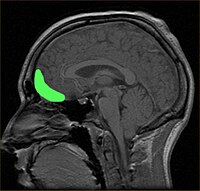
Photo from wikipedia
Even apparently simple choices, like selecting a dessert in a pastry shop, involve options characterized by multiple motivationally relevant attributes. Neuroeconomic research suggests that the human brain may track the… Click to show full abstract
Even apparently simple choices, like selecting a dessert in a pastry shop, involve options characterized by multiple motivationally relevant attributes. Neuroeconomic research suggests that the human brain may track the subjective value of such options, allowing disparate reward-predictive information to be compared in a common currency. However, the brain mechanisms involved in identifying value-predictive features and combining these to assess the value of each decision option remain unclear. Here, we review recent evidence from studies of multi-attribute decision-making in people with focal frontal lobe damage and in healthy people undergoing functional magnetic resonance imaging. This work suggests that ventromedial and lateral prefrontal cortex and orbitofrontal cortex are important for forming value judgments under conditions of complexity. We discuss studies supporting the involvement of these regions in selecting among and evaluating option attributes during value judgment and decision-making and when learning from reward feedback. These findings are consistent with roles for these regions in guiding value construction. They argue for a more nuanced understanding of how ventral and lateral prefrontal cortex contribute to discovering and recognizing value, processes that are required under the complex conditions typical of many everyday decisions.
Journal Title: F1000Research
Year Published: 2020
Link to full text (if available)
Share on Social Media: Sign Up to like & get
recommendations!